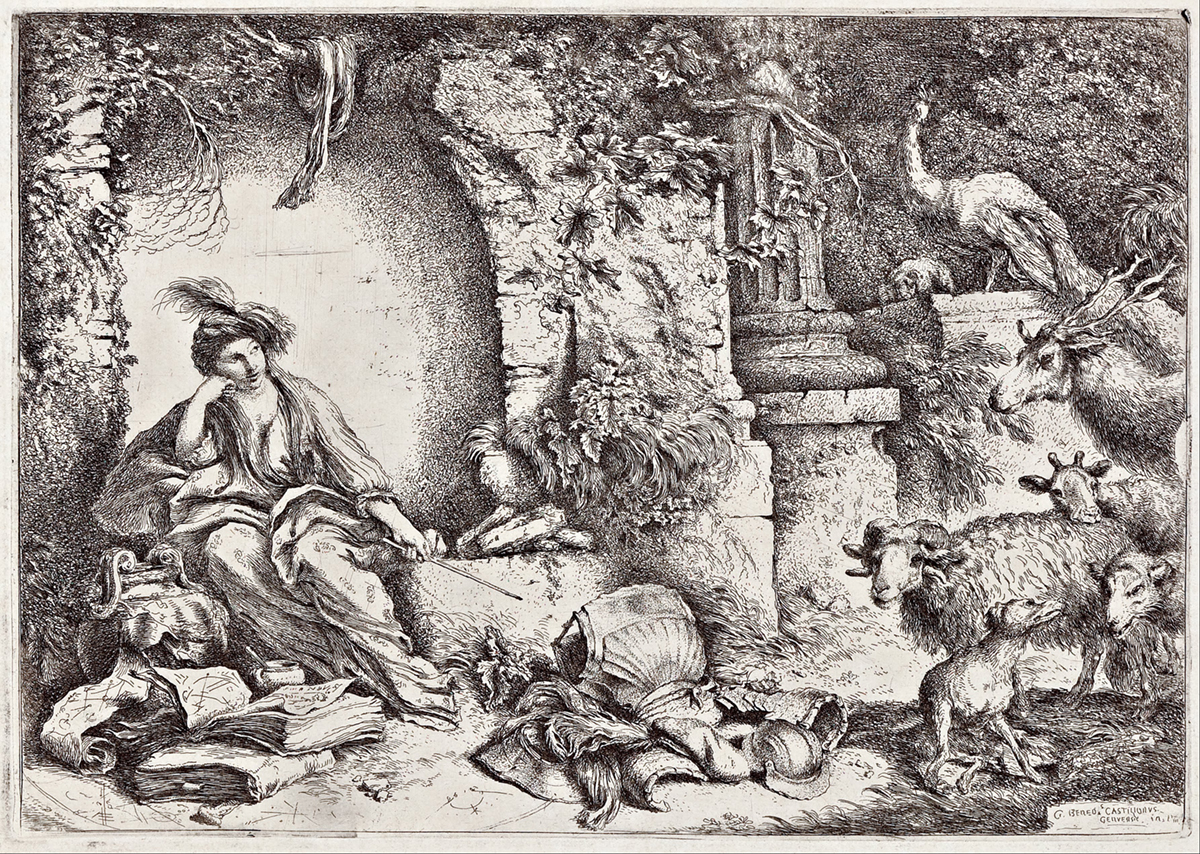
Giovanni Benedetto Castiglione’s etching Circe with companions of Ulysees changed into animals (1650–1651), demonstrates the artist’s technical skill and particular interest in depicting animals and mythical subjects. This print centres on Circe, the daughter of the Sun god Helios and the oceanic nymph Perse. A beautiful and powerful sorceress, Circe was adept at brewing potions and casting spells. According to famed Greek writer Homer in his epic poem “The Odyssey”, Circe feeds the male companions of the Greek King Ulysses a concocted potion and, with the help of her wand, transforms them into beasts.1 In Castiglione’s depiction of this tale, the men are transformed into animals, such as peacock, sheep, and deer. This menagerie is an unusual selection of creatures, given that the pig is the animal most commonly associated with this fable.2 References to animism may be read into this artwork, reinforcing the belief that all living things possess a human-like soul and inherent spirit. Castiglione’s intention in this regard, however, remains obscure. The assortment of armour that lies at Circe’s feet is testament to the metamorphosis from man to beast, hinting at a cautionary tale of predation and cruel revenge. Fear of feminine power and sexuality also infuses this artwork, with Circe poised as the destabilising force against the erotic impulses of man.
An intriguing element of this print is that Castiglione depicts Circe as melancholic, which recalls the form and disposition of figures regularly seen in works by Albrecht Dürer. At that time, melancholia was believed to represent an excess of black bile within the human body, which led to sinful behaviour and depression.3 Castiglione rendered eight depictions of Circe throughout his lifetime, each of which presented the sorceress as a melancholic, wand-wielding enchantress, thus a malevolent trickster and wrongdoer.4
Baroque artist, printmaker, and draftsman Giovanni Benedetto Castiglione (b. 1609 Genoa, Italy; d. 1664 Mantua, Italy) is known for his elaborate visual style. He is one of the earliest recorded artists to use the monotype printmaking technique, harnessing copper etching plates as his support.5
- Homer and G. M. Edwards, The Odyssey of Homer. Books VI and VII/ with notes and vocabulary by G. M. Edwards (Cambridge: Cambridge University Press, 1915).
- Ana Pairet, “Shades of Circe: Wisdom and knowledge in Christine de Pizan’s exempla,” French Forum 42, no. 3 (2017): 393–405.
- Guy Tal, “Witches on top: Magic, power, and imagination in the art of early modern Italy,” (PhD thesis, Indiana University, 2006).
- Ibid.
- Editors of Encyclopedia Britannica, “Monotype,” Encyclopedia Britannica, https://www.britannica.com/technology/monotype-printmaking.
Giovanni Benedetto Castiglione
Circe with companions of Ulysses changed into animals 1650–1651
Etching on paper
21.8 x 31 cm (plate); 31 x 46.3 (sheet)
V.B.F. Young Bequest Fund 2009
Collection of the Art Gallery of South Australia, Adelaide
